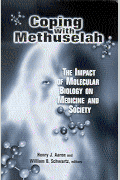The capacity to manipulate the genetic templates that shape all living beings was long the plaything of science fiction. In the final decades of the 20th century, however, intellectual advance transmuted genetic tinkering from alchemy into science. In 1953 two young scientists identified the double helix comprising four nucleotides entwined in the code of all life, thereby opening the first chapter in the saga of molecular biology. Then in 2001 two competing scientific teams produced a draft of the human genome, introducing a new therapeutic era in which medical professionals may be able to slow human aging and make celebrating 100th birthdays almost routine.
No one can predict the precise extent or timing of advances in molecular biology. No one can know exactly when particular diseases will be prevented or cured. No one can foresee when, or even if, human aging will be slowed or stopped. No one yet knows for sure whether humans’ genetic makeup limits life span or, if it does, what those limits might be. Some families include more nonagenarians and centenarians than any roll of nature’s dice could explain, a fact that suggests genes’ powerful influence on longevity. Even if life span is now limited, molecular biology may reveal that these limits are not fixed and may provide ways to slow aging and prevent or cure illnesses that cause physical decline and death.
Scientific advance has revolutionized man’s centuries-old assault on human illness. Physicians have long understood, in some sense, the basis of successful medical treatments, without being able to penetrate the underlying processes by which their interventions worked. The fundamental reasons why antibiotics killed pathogens, for example, remained for years as mysterious to the discoverers of those drugs and to the physicians who used them as they were to the patients whose lives they saved.
As the 21st century begins, scientists are increasingly working from a fundamental understanding of cells, proteins, and genes to design interventions that reverse, block, or otherwise forestall illnesses. In the words of Nobel Prize winner Alfred Gilman, scientists are now “able to complete [their] understanding of the wiring diagram of the signaling switchboard in each type of cell.” With that knowledge in hand, they now have—or soon will—the means to design drugs or to directly change how cells operate to correct the genetic defects each person inherits or acquires during life from mutations or other sources.
In the coming century, human mortality rates may begin falling rapidly. Eventually molecular biology may lengthen human life almost unimaginably. Is the Age of Methuselah at hand? And if so, what will it mean for public policy in the United States—and the world?
Our Uncertain Demographic Future
Advances in public health, nutrition, and medical treatment over the past century first set in motion an increase in human life expectancy. With mortality rates now declining roughly 0.6 percent a year, demographers project that longevity will continue to increase and that the elderly will constitute a growing share of the U.S. population. A biomedical revolution causing mortality rates to fall more rapidly could intensify these trends and have important demographic implications.
Many scientists have long believed that the human life span has a natural limit. The finding by 19th-century scientist August Wiseman that cells stopped reproducing after a certain number of divisions seems consistent with this hypothesis. But even if a natural limit exists, the practical question is how far that limit exceeds current average life span and what can be done to push today’s life span closer to that limit. One theory of aging draws an analogy between a person and a machine consisting of many systems, each essential for its operation. Each system within the machine remains functional until too many of its constituent parts fail, leading the machine itself to fail over time in patterns that closely resemble human mortality rates. The implication is that medical progress comes through interventions that prevent or postpone the failure of the constituent parts of each of the biological “systems” essential for life.
Rapidly falling mortality rates would affect longevity relatively quickly but would take many years to alter the age distribution of the population. The U.S. Social Security Administration, which assumes that mortality rates will continue to decline at the current annual rate, about 0.6 percent, projects that people born in 2030 will have a life expectancy at birth of just over 84 years; those born in 2075, just over 86. If mortality rates decline 2 percent a year, babies born in 2030 could expect to live 104 years; those born in 2075, more than 115 years. But even this rapid rate of decline would have little effect on the U.S. population distribution until past mid-century.
How would rapidly declining mortality affect the U.S. workplace and public programs to support the elderly? Much would depend on the onset of physical decline in the longer-lived Americans. Would greatly increased longevity mean longer periods of dependency? Or would older Americans stay healthy longer? If workers were able to keep working for a greater portion of their lives than they do now, the cost of supporting the elderly might increase only slightly because the ratio of retirees to active workers might increase only a little. If current retirement age patterns persisted, however, the cost of increased longevity would rise sharply as people spent ever more years outside the labor force.
Little in economic theory or empirical evidence suggests that sharply increased longevity would directly affect retirement behavior. But if workers extended their years in retirement, it would boost pension costs, which, in turn, would probably force changes in public policy to encourage workers to extend their working lives. Higher pension costs would necessitate sharply increased pension contributions by workers or their employers, or higher taxes on workers and employers to support public pensions, or cuts in benefits and increases in the age at which pensions are first paid. These changes would likely cause Americans to work more years than they now do.
Rapidly falling mortality would certainly affect government revenues and spending. If longer-living Americans extended their working lives, they would earn and produce more, swelling tax revenues. But increased longevity would also boost government spending on Social Security, Medicare, and Medicaid, all of which are already projected to grow rapidly as baby boomers begin retiring. And a major new decline in mortality rates would drive spending above these already steeply rising trends.
Social Security costs are officially projected to increase between now and 2080, from just under 11 percent to just over 20 percent of earnings subject to the Social Security payroll tax. If mortality rates were to fall 2 percent annually while the duration of working lives remained the same, Social Security costs would reach more than 25 percent of payroll. Raising the age at which full Social Security benefits are paid by one month a year starting in 2018 would eliminate most of the additional longevity-related cost. The message is simple and clear: as longevity increased, so too would Social Security costs.
Projecting the effects of longevity on Medicare and Medicaid costs is much trickier because spending depends not only on the number of beneficiaries, but also on trends in the cost of medical care. Regardless of trends in mortality rates, Medicare and Medicaid costs will soar because per capita medical costs for everyone will increase. Medical spending also rises with age as people’s bodies gradually wear out or become subject to disease. Some observers see decline as an immutable consequence of a person’s age since birth—an 80-year-old whose life expectancy is 85 will be in the same state of decline as an 80-year-old whose life expectancy is 110. But Stanford University economist John Shoven thinks it more plausible that medical spending depends on years until death. And the fact that disability rates have fallen as mortality rates have improved supports that view. If mortality declines at historical rates, projections based on the years-since-birth assumption show Medicare costing about 2 percent of gross domestic product more in 2070 than if costs are projected on the years-until-death assumption. The difference jumps to roughly 5 percent of GDP if mortality rates fall 2 percent a year. In the case of Medicaid, the cost difference in 2070 between projections is a bit over 1 percent of GDP if mortality declines at officially assumed rates, but nearly 6 percent if it declines 2 percent a year.
The story is straightforward. Costs of Social Security, Medicare, and Medicaid will rise during the early part of the 21st century, primarily because of the aging of the baby-boom generation and—in the case of the health programs—increases in medical costs. Accelerated increases in longevity would affect costs primarily in the second half of the century and beyond. If, in the best scenario, physical decline were delayed as lives were lengthened, the added health care costs would be modest. If, in addition, working lives increased, the added revenues from a bigger labor force would help defray these costs.
A Global Perspective
The effects of a sharp increase in longevity would not be confined to one nation. The swelling ranks of the elderly already threaten pension systems in many countries and may have important effects on international capital flows. Dramatically increased longevity would require most developed nations to reform their retirement systems to keep them sustainable. Increased public spending on retirement would lower saving rates in developed nations, which could prevent many developing nations from borrowing to finance growth.
Over the past 150 years, both birth and mortality rates have fallen nearly everywhere. From the standpoint of economic development, the ideal pattern is a drop in birth rates followed years later by declining mortality. That pattern keeps the ratio of the working-age population to the total population quite high for a time, enabling domestic saving to support high rates of investment. Eventually, however, the aged population increases. If birth rates remain low, overall population, excluding immigration, will fall.
Only wealthy nations would be able to afford the costly medical interventions that would sharply increase longevity. Because mortality rates in those nations are already low among younger citizens, declining mortality rates primarily would increase the number of those over age 50. The ratio of the elderly to the working-age population would therefore increase most in wealthy nations. The most extreme effects would show up in nations such as Japan, where the elderly population is already 71 percent as large as the working-age population. The effect in the United States would be much smaller because above-average birth and immigration rates are projected to keep the working-age population growing at least slowly.
Current population aging is already likely to lower both saving and investment in high-income countries and to increase saving in middle-income and poor nations, pushing foreign trade balances of rich nations into deficit and those of the rest of the world into surplus. A 2-percent-a-year reduction in mortality rates would intensify these effects. Saving would decline sharply, investment somewhat less. With mortality falling fastest in nations that can afford medical innovation, trade deficits are especially likely for rich nations.
These projections are tentative and depend heavily on how increasing longevity affects the world of work. If people’s working lives lengthen, investment will be higher, the cost of private and public pensions lower. Technological change will also influence investment opportunities and the call on saving to finance that investment. Nevertheless, extending longevity is likely to be quite expensive, and rich nations are far more likely than poor nations to incur those costs.
The Ethical Dilemmas of Increasing Longevity
Throughout the 20th century, public health advances, rising income, and medical discoveries added decades to life expectancy at birth. These advances raised practical questions, such as how to pay for pension and health costs for the elderly, but relatively few ethical problems. Some painful moral problems did arise: whether it is ever right—and, if so, under what circumstances and after what steps—to curtail care for extremely ill patients or to allow severely damaged newborns to die. But few observers questioned whether clean water, the reduction of poverty, or effective antibiotics were ethically desirable.
The prospect of an engineered extension of human life, however, has created a major stir among ethicists. As Alexander Morgan Capron, University Professor of Law and Medicine at the University of Southern California, notes, past developments in longevity took opportunities once available to the few and extended them to the many. But some interventions now in prospect would change the fundamental character of humans—for example, by changing their genes.
The ethical issues raised by life extension depend in part on its consequences. Most problematic would be increasing the average age of death primarily by increasing a person’s years of physical and mental decline. But, as Capron points out, no one can foresee whether the coming scientific advances will add decades of mental and physical vigor or decades of senility and debility.
The ethical issues will also be shaped by the means used to increase longevity. Irreversible interventions, such as altering human genes, raise more questions than do interventions that can be stopped, such as a hormone that a patient can stop taking. And many innovations that promise to extend life will require risky experimentation and must be attended by stringent procedural safeguards.
Another issue is access to life-extending interventions. Capron dismisses the views of some ethicists that once a person has reached a “normal” life span, access to life-extending care is not ethically required. Both the duration of “normal” lives and the content of “normal” interventions, he notes, are inescapably elastic. Both depend on expectations that are themselves influenced by technological possibilities.
Finally, Capron notes that questions about suicide and passive euthanasia are likely to become increasingly prominent. If the capacity to extend life is available, is it euthanasia if caregivers do not use it—or suicide if patients actively reject it?
Leon Kass, Francis Fukayama, and others have posited that life extension is not a legitimate goal of science and that success in such an endeavor threatens to deprive people of essential attributes of their humanity. Finitude, they argue, lends life savor, sweetness, and value. A quest for superhuman intelligence, looks, or longevity is quite literally inhuman. Gradually, step by step, like the person immersed in a bath slowly warming from comfortable to lethal, humans would surrender what it means to be human by a series of steps each seemingly reasonable, but cumulatively dehumanizing. Capron is more concerned that successful life extension could produce a dystopia with ever-larger parts of life spent in dependence.
When Imagined Futures Become Real
A flowering of biomedical science holds the promise, though not the certainty, that human beings will soon live routinely to ages almost unthinkable today. Although such a development still has an air of science fiction for most Americans, its implications must be considered seriously. Authors of fiction tend to place utopias and dystopias in an imagined future. Readers may be revulsed by the nightmares of Brave New World or 1984, chilled by the cold impersonality of The Rise of the Meritocracy, or swept by the romantic notions of Looking Backward. The authors of these imagined futures had a free hand to paint with their chosen palettes. Social scientists, having no such license, must contemplate with academic detachment the problems, challenges, and opportunities to be faced if living to 90, 100, or beyond becomes common. Utopias do not adorn the pages of honest analysis.



Commentary
Coping with Methuselah: Public Policy Implications of a Lengthening Human Life Span
September 1, 2003